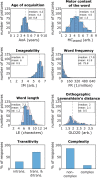German normative data with naming latencies for 283 action pictures and 600 action verbs
- PMID: 34341962
- PMCID: PMC9046323
- DOI: 10.3758/s13428-021-01647-w
German normative data with naming latencies for 283 action pictures and 600 action verbs
Abstract
Timed picture naming is a common psycholinguistic paradigm. In this task, participants are asked to label visually depicted objects or actions. Naming performance can be influenced by several picture and verb characteristics which demands fully characterized normative data. In this study, we provide a first German normative data set of picture and verb characteristics associated with a compilation of 283 freely available action pictures and 600 action verbs including naming latencies from 55 participants. We report standard measures for pictures and verbs such as name agreement indices, visual complexity, word frequency, word length, imageability and age of acquisition. In addition, we include less common parameters, such as orthographic Levenshtein distance, transitivity, reflexivity, morphological complexity, and motor content of the pictures and their associated verbs. We use repeated measures correlations in order to investigate associations between picture and word characteristics and linear mixed effects modeling for the prediction of naming latency. Our analyses reveal comparable results to previous studies in other languages, indicating high construct validity. We found that naming latency varied as a function of entropy of responses, word frequency and motor content of pictures and words. In summary, we provide first German normative data for action pictures and their associated verbs and identify variables influencing naming latency.
Keywords: Action naming; German; Motor content; Name agreement; Normative data; Picture naming; Verbs.
© 2021. The Author(s).
Conflict of interest statement
L.T. reports honoraria from Medtronic Inc., Boston Scientific Corporation, Bial, Zambon Pharma, UCB Schwarz Pharma, Desitin Pharma and Abbott Laboratories, outside the submitted work. J.L.B., F.S.H., F.D., I.W. and C.R.O. declare no competing interests.
Figures




Similar articles
-
Polish norms for a set of colored drawings of 168 objects and 146 actions with predictors of naming performance.Behav Res Methods. 2023 Aug;55(5):2706-2732. doi: 10.3758/s13428-022-01923-3. Epub 2022 Aug 1. Behav Res Methods. 2023. PMID: 35915359 Free PMC article.
-
Gulf Arabic nouns and verbs: A standardized set of 319 object pictures and 141 action pictures, with predictors of naming latencies.Behav Res Methods. 2018 Dec;50(6):2408-2425. doi: 10.3758/s13428-018-1019-6. Behav Res Methods. 2018. PMID: 29450704
-
The adaptation of the Object and Action Naming Battery into Moroccan Arabic: Norms for name agreement, frequency, imageability, visual complexity, and age of acquisition.Appl Neuropsychol Adult. 2024 Sep-Oct;31(5):923-931. doi: 10.1080/23279095.2022.2089041. Epub 2022 Jun 28. Appl Neuropsychol Adult. 2024. PMID: 35764426
-
Psycholinguistic norms for 92 action pictures and verbs in the Persian language in young- and middle-aged people.Appl Neuropsychol Adult. 2022 Sep-Oct;29(5):1198-1207. doi: 10.1080/23279095.2020.1864373. Epub 2021 Jan 19. Appl Neuropsychol Adult. 2022. PMID: 33463375
-
Naming the menagerie: creativity, culture and consequences in the formation of scientific names.Proc Biol Sci. 2023 Nov 8;290(2010):20231970. doi: 10.1098/rspb.2023.1970. Epub 2023 Nov 1. Proc Biol Sci. 2023. PMID: 37909078 Free PMC article. Review.
Cited by
-
Jiwar: A database and calculator for word neighborhood measures in 40 languages.Behav Res Methods. 2025 Feb 19;57(3):98. doi: 10.3758/s13428-025-02612-7. Behav Res Methods. 2025. PMID: 39971880 Free PMC article.
-
NoLiTiA: An Open-Source Toolbox for Non-linear Time Series Analysis.Front Neuroinform. 2022 Jun 24;16:876012. doi: 10.3389/fninf.2022.876012. eCollection 2022. Front Neuroinform. 2022. PMID: 35811996 Free PMC article.
-
Polish norms for a set of colored drawings of 168 objects and 146 actions with predictors of naming performance.Behav Res Methods. 2023 Aug;55(5):2706-2732. doi: 10.3758/s13428-022-01923-3. Epub 2022 Aug 1. Behav Res Methods. 2023. PMID: 35915359 Free PMC article.
References
-
- Bates, D., Mächler, M., Bolker, B., & Walker, S. (2015). Fitting Linear Mixed-Effects Models Using lme4. Journal of Statistical Software, 67(1). 10.18637/jss.v067.i01
MeSH terms
LinkOut - more resources
Full Text Sources

